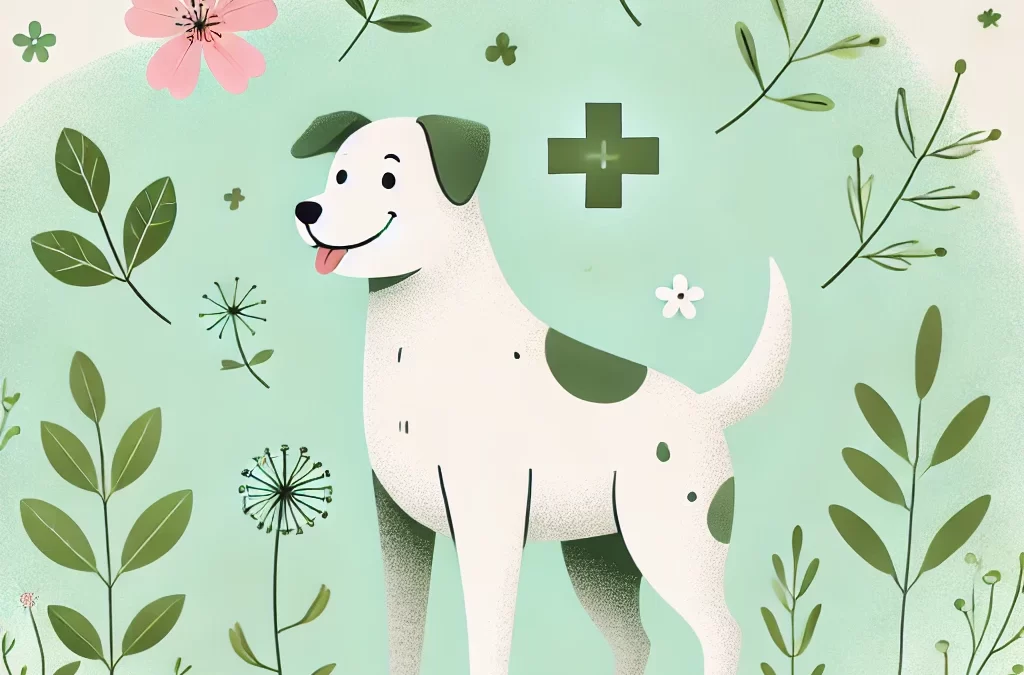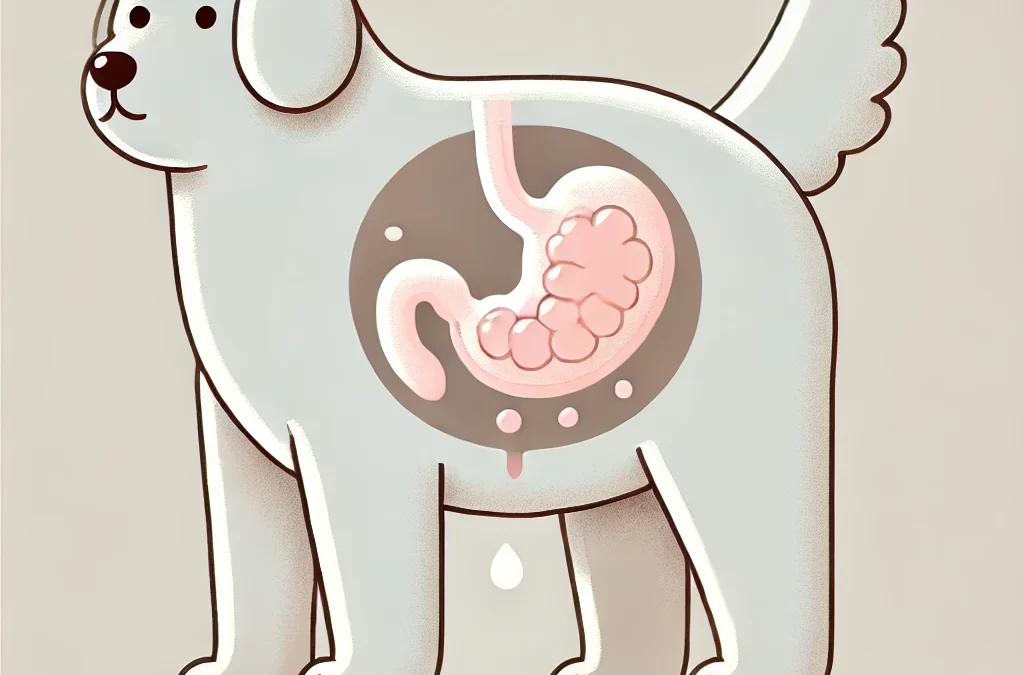
by TCMVET | Dec 9, 2024 | Dog Cancer & Tumors
Spinal tumors in dogs, though rare, can severely impact their mobility and quality of life. These tumors may develop within or around the spinal column, affecting the nervous system’s function. Early detection and proper management are essential to providing the best care for your furry friend. Here’s a comprehensive guide to the types of spinal tumors in dogs and their symptoms, causes, and treatment options.
Common Types of Spinal Tumors in Dogs
- Intramedullary Tumors
- Description: These tumors originate within the spinal cord itself. They often arise from glial cells, which support the nervous system.
- Examples: Astrocytomas, ependymomas, and oligodendrogliomas
- Symptoms: Gradual weakness, incoordination, and possible paralysis in severe cases
- Treatment: Surgery (if possible), radiation therapy, and supportive care
- Extradural Tumors
- Description: These tumors occur outside the spinal cord but within the spinal canal, often compressing the cord and causing neurological issues.
- Examples: Osteosarcomas, fibrosarcomas, and lymphomas
- Symptoms: Back pain, difficulty walking, and muscle weakness
- Treatment: Surgical removal, chemotherapy, or radiation, depending on the tumor type
- Intradural-Extramedullary Tumors
- Description: Located within the spinal canal but outside the spinal cord, these tumors grow in the surrounding meninges or nerve roots.
- Examples: Meningiomas, nerve sheath tumors (schwannomas)
- Symptoms: Pain, incoordination, and possible urinary or bowel incontinence
- Treatment: Surgery and radiation therapy
- Vertebral Tumors
- Description: These tumors arise from the bones of the spine, causing structural instability and potential compression of the spinal cord.
- Examples: Osteosarcoma, chondrosarcoma
- Symptoms: Severe pain, swelling, and difficulty standing or walking
- Treatment: Surgery, chemotherapy, and pain management
Symptoms of Spinal Tumors in Dogs
The symptoms of spinal tumors can vary depending on the tumor’s location and size, but common signs include:
- Reluctance to move or play
- Difficulty walking or dragging limbs
- Pain or sensitivity in the back or neck
- Loss of bladder or bowel control
- Sudden changes in behavior or posture
Causes and Risk Factors
Spinal tumors in dogs may be caused by:
- Genetic Predisposition: Certain breeds like German Shepherds and Golden Retrievers may be at higher risk.
- Age: Older dogs are more likely to develop spinal tumors.
- Cancer Metastasis: Tumors from other parts of the body may spread to the spine.
Diagnosis and Treatment
Veterinarians use several methods to diagnose spinal tumors:
- Neurological Examination: Assesses reflexes, coordination, and pain response.
- Imaging: X-rays, MRI, or CT scans to locate and evaluate the tumor.
- Biopsy: Confirms the tumor type for targeted treatment.
Treatment options include:
- Surgery: The preferred method for accessible and operable tumors.
- Radiation Therapy: Used for inoperable or residual tumors post-surgery.
- Chemotherapy: Effective for some metastatic or primary spinal tumors.
- Pain Management: Essential for improving the dog’s quality of life.
Supporting Your Dog Through Recovery
Care for dogs with spinal tumors should include:
- Providing a soft, supportive bed to prevent pressure sores
- Assisting with mobility through harnesses or carts
- Maintaining a nutritious diet to support overall health
- Regular follow-ups with the vet to monitor progress
Conclusion
Spinal tumors in dogs require prompt attention and specialized care. While the prognosis depends on the tumor type and progression, advancements in veterinary medicine have made treatments more effective. By understanding the symptoms and options available, you can ensure your dog receives the best care and support.

by TCMVET | Dec 9, 2024 | Dog Cancer & Tumors
Skin health in dogs is often a mirror of their overall well-being, yet some conditions can be puzzling for even the most attentive pet owners. One such rare condition is cornifying epitheliomas, a type of benign skin tumor that can cause concern due to its appearance and effects. Let’s delve into this unusual dermatological condition, its causes, treatments, and what makes it a unique challenge in canine healthcare.
What Are Cornifying Epitheliomas?
Cornifying epitheliomas are benign tumors that originate from sebaceous glands, specifically the epithelium (skin cells) responsible for keratin production. These tumors often present as nodular, wart-like growths on a dog’s skin. While they are not life-threatening, their potential to cause discomfort or infection means they shouldn’t be ignored.
What Causes Cornifying Epitheliomas?
The exact cause of cornifying epitheliomas isn’t fully understood, but contributing factors may include:
- Genetic Predisposition: Breeds such as Cocker Spaniels, Beagles, and Siberian Huskies are more prone to developing these growths.
- Hormonal Imbalances: Sebaceous gland activity can be influenced by hormonal changes, particularly in older dogs.
- Dietary Deficiencies: Poor nutrition can lead to imbalances in skin health, potentially exacerbating conditions like epitheliomas.
Recognizing the Symptoms
Cornifying epitheliomas typically appear as:
- Small, firm nodules with a wart-like texture
- Yellowish or waxy in color due to keratin build-up
- Localized around the head, neck, or back but can occur anywhere
- Occasionally accompanied by redness or inflammation if secondary infection occurs
While these growths are benign, rapid changes in size, color, or texture should be evaluated by a veterinarian to rule out malignancies.
Diagnosing Cornifying Epitheliomas
Diagnosis usually involves:
- Physical Examination: A veterinarian will assess the size, location, and appearance of the growths.
- Fine-Needle Aspiration (FNA): A sample of cells is extracted and analyzed to confirm the nature of the tumor.
- Biopsy: In some cases, a biopsy may be necessary to differentiate between benign epitheliomas and other skin conditions or cancers.
Treatment Options
Treatment depends on the severity and impact of the epitheliomas on your dog’s quality of life.
- Monitoring
For small, non-problematic growths, regular monitoring is often sufficient.
- Ensure the area remains clean and free from infection.
- Use soothing topical treatments if recommended by your vet.
- Surgical Removal
If the growths are causing discomfort, recurring infections, or cosmetic concerns, surgical removal is a common solution.
- Minimally invasive techniques like laser surgery can reduce recovery time.
- Topical or Systemic Therapies
- Retinoids or vitamin A supplements can regulate keratin production.
- Antibiotics may be prescribed for secondary bacterial infections.
Innovative and Natural Approaches
For owners looking to complement conventional treatments with holistic care:
- Omega-3 Fatty Acids: These can reduce inflammation and promote overall skin health.
- Herbal Remedies: Calendula and aloe vera can soothe irritated areas.
- Dietary Adjustments: A diet rich in antioxidants and high-quality proteins supports skin regeneration.
Preventive Measures
Although not all cases of cornifying epitheliomas can be prevented, these steps can help maintain optimal skin health:
- Regular Grooming: Keeps the skin clean and promotes early detection of abnormalities.
- Balanced Diet: Supports the immune system and reduces the likelihood of skin issues.
- Routine Veterinary Visits: Early intervention is key to managing any skin condition.
A Unique Challenge in Canine Dermatology
Cornifying epitheliomas highlight the importance of understanding and addressing even rare conditions in dogs. While benign, these growths can impact your pet’s comfort and appearance, making prompt and effective management essential. By staying informed and working closely with your veterinarian, you can ensure your dog remains healthy, happy, and thriving.

by TCMVET | Dec 8, 2024 | Dog Cancer & Tumors
tment Options
Dogs often lick their bodies instinctively, whether to groom themselves or soothe discomfort. However, when your dog persistently licks at a specific area, such as a tumor, it may indicate an underlying issue that requires attention. This article explores why dogs lick tumors, the potential risks, and effective ways to address the issue.
Why Do Dogs Lick Tumors?
Licking is a natural behavior for dogs, but persistent licking at a tumor can indicate several underlying reasons:
- Discomfort or Pain
Tumors, particularly those that are inflamed or ulcerated, may cause irritation. Dogs often lick to try to alleviate this discomfort.
- Infection or Discharge
Some tumors may produce blood, pus, or other fluids, which dogs instinctively attempt to clean through licking.
- Curiosity
Dogs are tactile and sensory-driven creatures. A growth or lump may feel unusual, prompting them to investigate by licking.
- Anxiety or Stress
Emotional distress can manifest in licking behavior. Dogs may focus on areas of discomfort as a self-soothing mechanism.
Risks of Tumor Licking
While licking may seem harmless, it can lead to complications:
- Infection: Bacteria introduced through licking can cause secondary infections.
- Ulceration: Persistent licking can damage the skin over the tumor, causing further irritation and bleeding.
- Delayed Healing: If the tumor has been treated or removed, licking can disrupt the healing process.
- Spread of Malignant Cells: In rare cases, irritation from licking may exacerbate the spread of cancerous cells.
How to Prevent Licking
Taking immediate action to stop your dog from licking a tumor is crucial to avoid further complications.
- Consult a Veterinarian
A vet should examine the tumor to determine whether it is benign or malignant and recommend an appropriate course of action.
- Use Protective Gear
Consider an Elizabethan collar, inflatable collar, or body suit to prevent your dog from accessing the tumor.
- Address the Root Cause
Depending on the diagnosis, treatment may involve surgery, medication, or a combination of both to alleviate discomfort and address the tumor.
- Maintain Hygiene
Keeping the affected area clean and following your vet’s instructions can prevent infections and reduce irritation.
Supporting Your Dog’s Recovery Naturally
In addition to conventional treatments, natural therapies can provide extra support for your dog’s health. Products like TCMVET Baituxiao, based on traditional Chinese medicine, are specifically formulated to help manage tumor growth and support immune function.
Pet owners have shared positive experiences with TCMVET Baituxiao, noting improvements in their pets’ energy and comfort levels. It can be an excellent addition to a comprehensive care plan, though it’s essential to consult your veterinarian before introducing any new supplement.
Caring for Your Dog’s Well-Being
If your dog is licking a tumor, it’s a clear sign that something is amiss. Taking steps to address the behavior and seeking professional guidance can make all the difference in your pet’s health. Combining veterinary care with natural supplements like TCMVET Baituxiao may enhance your dog’s quality of life and provide the best possible support during their recovery.
By staying attentive and proactive, you can ensure your dog remains comfortable and cared for, no matter the challenges they face.

by TCMVET | Dec 8, 2024 | Dog Cancer & Tumors
Cancer is one of the most challenging health issues faced by dog owners. Often mistaken for signs of aging or minor ailments, the symptoms of cancer in dogs can easily go unnoticed until the disease has progressed. This article takes a fresh approach to understanding dog cancer symptoms and explores how natural therapies can play a role in supporting your pet’s health.
Common Symptoms of Cancer in Dogs
Detecting cancer early can make a significant difference in treatment outcomes. Here are some common signs to watch for:
- Lumps or Swelling: Persistent lumps or unusual swelling in areas like the neck, legs, or abdomen should never be ignored.
- Changes in Appetite: A sudden loss of interest in food or difficulty eating can indicate underlying health issues.
- Unexplained Weight Loss: Significant weight changes without dietary or activity adjustments may signal cancer.
- Behavioral Changes: Increased lethargy, reluctance to exercise, or signs of discomfort might point to internal health problems.
- Abnormal Discharges: Persistent nasal discharge, blood in the stool, or unusual smells can be warning signs.
- Non-healing Wounds: If a wound or sore doesn’t heal within a reasonable time, it could indicate a deeper issue.
The Role of Natural Therapies in Cancer Care
While conventional treatments like surgery, chemotherapy, and radiation are often necessary, they can be costly and may come with side effects. This is where natural therapies step in as a complementary approach. Herbs and supplements, when carefully selected, can help enhance your pet’s quality of life and support their recovery.
One such natural supplement is TCMVET Baituxiao, a formula inspired by traditional Chinese medicine. It is designed to support dogs by reducing tumor growth and promoting overall balance in the body. Pet owners have reported improvements in their dog’s energy levels and well-being when using this product alongside veterinary care.
Supporting Your Dog’s Journey
If your dog is exhibiting any of the symptoms mentioned above, consult your veterinarian immediately for a thorough diagnosis. Early detection, combined with a holistic approach to treatment, can make all the difference in your pet’s journey.
Incorporating natural therapies like TCMVET Baituxiao into your dog’s care routine not only complements traditional treatments but also provides additional support for their overall health. By staying informed and proactive, you can ensure your furry companion receives the best care possible.

by TCMVET | Dec 7, 2024 | Dog Cancer & Tumors
Transitional Cell Carcinoma (TCC) is the most common type of urinary bladder cancer in dogs, often presenting significant challenges for both pets and their owners. Despite its aggressive nature, early detection and a proactive approach to treatment can help improve a dog’s quality of life.
What is Transitional Cell Carcinoma?
TCC is a malignant cancer that typically originates in the epithelial lining of the bladder, particularly in the trigone area, where the urethra and ureters meet. Although it primarily affects the bladder, it can spread to the urethra, prostate, lymph nodes, and other organs if left untreated.
Which Dogs are at Risk?
While TCC can affect any dog, certain breeds are predisposed, including:
- Scottish Terriers (highest risk)
- Shetland Sheepdogs
- West Highland White Terriers
- Beagles
Female dogs and older dogs are more likely to develop TCC, though the condition is not exclusive to these groups.
Symptoms to Watch For
Early signs of TCC can resemble common urinary tract infections, which makes diagnosis tricky. Key symptoms include:
- Straining to urinate (dysuria)
- Increased frequency of urination (pollakiuria)
- Blood in the urine (hematuria)
- Urinary incontinence
- Difficulty passing urine or complete blockage
As the disease progresses, symptoms such as lethargy, weight loss, and abdominal pain may emerge.
How is TCC Diagnosed?
Diagnosing TCC requires a combination of tests to rule out other conditions and confirm the presence of cancer:
- Urinalysis: Helps detect blood, bacteria, or abnormal cells.
- Imaging: Ultrasound or X-rays can reveal bladder masses.
- Cystoscopy: Direct visualization of the bladder for biopsy collection.
- BRAF Mutation Test: A non-invasive urine test that detects mutations associated with TCC.
Early and accurate diagnosis is critical to implementing an effective treatment plan.
Treatment Options
While TCC is rarely curable, various treatments can manage the disease and improve the dog’s quality of life:
- Medications:
- Non-Steroidal Anti-Inflammatory Drugs (NSAIDs) such as piroxicam are often prescribed for their anti-cancer properties.
- Chemotherapeutic agents like mitoxantrone or vinblastine may be used alone or in combination with NSAIDs.
- Surgery:
- Surgical removal of the tumor is an option if it is localized, but the tumor’s location in the trigone area often makes this difficult.
- Radiation Therapy:
- Can help shrink tumors and alleviate symptoms when surgery is not feasible.
- Palliative Care:
- Focuses on maintaining comfort through pain management and addressing urinary obstructions.
Living with TCC: What Owners Should Know
Managing a dog with TCC involves regular veterinary check-ups and monitoring for symptoms. Here are some tips for pet owners:
- Diet and Hydration: Provide a balanced diet and ensure the dog stays hydrated to support urinary health.
- Medications: Administer prescribed drugs consistently and report any side effects to your vet.
- Observation: Watch for changes in urination patterns or signs of discomfort.
- Emotional Support: TCC can be stressful for both the pet and the owner, so seek support from your vet or pet communities.
Prognosis
The prognosis for dogs with TCC varies depending on the stage of the disease and the treatment plan. With appropriate care, many dogs can live comfortably for months or even over a year post-diagnosis. Early detection and a proactive approach can make a significant difference in extending a dog’s life and maintaining their quality of life.
Final Thoughts
While transitional cell carcinoma is a serious diagnosis, advancements in veterinary medicine provide hope and options for pet owners. By understanding the disease and working closely with your veterinarian, you can ensure your dog receives the best care possible.

by TCMVET | Dec 7, 2024 | Dog Cancer & Tumors
Discovering a large abdominal mass in a dog can be alarming for any pet owner. While it is natural to worry, understanding the potential causes, symptoms, and treatment options can empower you to make informed decisions about your dog’s health.
What is an Abdominal Mass?
An abdominal mass is an abnormal growth in the stomach area that may arise from organs such as the liver, spleen, intestines, or even surrounding tissues. These masses can vary significantly in size and may be benign (non-cancerous) or malignant (cancerous).
Common Causes of Abdominal Masses
- Benign Growths
- Lipomas: Fatty tumors that are generally harmless.
- Cysts: Fluid-filled sacs that may grow over time but are typically non-threatening.
- Malignant Tumors
- Hemangiosarcoma: A common cancer affecting the spleen.
- Lymphoma: Affects lymph nodes and can spread to the abdomen.
- Carcinomas: Tumors arising from epithelial tissues of internal organs.
- Other Causes
- Abscesses: Infections that lead to pus-filled pockets.
- Organ Enlargement: Conditions like liver disease can mimic mass growth.
Symptoms to Watch For
Early detection can significantly impact outcomes. Look for:
- Swollen or distended abdomen
- Weight loss or reduced appetite
- Vomiting or diarrhea
- Lethargy or signs of discomfort
- Difficulty breathing due to abdominal pressure
Diagnosis
Diagnosing an abdominal mass requires a veterinarian’s expertise. Procedures may include:
- Physical Examination: Palpating the abdomen to detect unusual growths
- Imaging Tests: Ultrasound or X-rays to determine the size, location, and nature of the mass
- Biopsy or Fine Needle Aspiration: Collecting tissue samples for analysis
- Blood Tests: Checking for related health conditions
Treatment Options
The treatment depends on the mass’s type and location:
- Surgical Removal: Often the first line of action for operable masses
- Chemotherapy or Radiation: Used for malignant growths, especially if surgery isn’t possible
- Palliative Care: Focuses on maintaining comfort if the condition is untreatable
Proactive Steps for Pet Owners
- Routine Check-ups: Regular veterinary visits can help catch problems early
- Monitor Symptoms: Keep an eye on any changes in your dog’s behavior or appetite
- Proper Nutrition: A balanced diet supports overall health and recovery
- Second Opinions: Don’t hesitate to consult another vet for complex cases
Large abdominal masses in dogs are a serious concern, but with timely veterinary care and proper management, many dogs can achieve good outcomes. Always work closely with your vet to determine the best course of action for your furry friend.






